Chris Mc Loone
It’s trite to say at this point, but the reality of the fire service today is continual refinement of tactics to fit a reduced workforce, aging apparatus, and increased calls for emergency medical service (EMS). With this in mind, ESI Equipment, Inc., headquartered in Montgomeryville, Pennsylvania, has partnered with Fibrobec, based in Montreal, Canada, to develop a small, inexpensive fire apparatus that can handle 80 percent of the normal responses for which most city and densely populated area fire departments are called. “ESI’s first concept demonstration unit was an idea based on what was being said by chiefs across North America-that we need to find a more efficient and economical way of delivering our services to the public,” says John Evans, president, ESI Equipment, Inc.
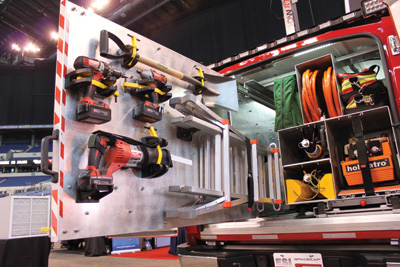 |
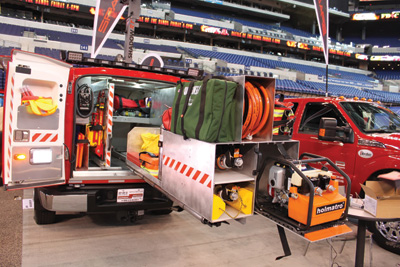 |
| (1, 2) ESI’s SpaceKap RIU concept vehicle includes a full system of portable hydraulic rescue equipment, stabilization systems, pike poles, power hand tools, shovel, broom, two backboards, Little Giant® ladder, bolt cutters, spill material, mini come-along kit, pressurized water and dry chemical extinguishers, traffic cones, tool kits, and highway vests all placed on a rear slide-out tray and slide-out wall. (Photos courtesy of ESI Equipment, Inc.) |
Origin
According to Evans, the concept for the SpaceKap Rapid Intervention Unit (RIU) originated when Fibrobec decided to enter the emergency services market. The company has manufactured commercial caps and insert bodies for more than 30 years. “With little experience in this market, they sought some outside assistance,” says Evans. Fibrobec approached ESI Equipment, Inc. at the urging of a mutual business colleague. “ESI, having more than 20 years of custom installation in emergency apparatus, was a good fit to explore a new concept in emergency response vehicles,” adds Evans. From there, a mutual business relationship began, wherein Fibrobec provides ESI with a body shell that slides into the bed of a pickup truck and is secured using a patented clamping system. “This allows easy insertion and removal of the body similar to a pickup camper,” says Evans.”
Fibrobec’s RIU body differs from the commercial SpaceKaps body in many ways. The roof is reinforced to accommodate light towers, other devices, and internal structural additions. There is 10 percent more fiberglass used in production, and there are two additional insulation barrier layers sandwiched in the body. If painted, there is a base coat and two clear coats with painted edges around all doors. The RIU also has four Luma Bar LED fixtures in the body and side doors and two independent electrical connection boxes and cables.
Fibrobec concentrates on the exterior body design. ESI concentrates on the interior configurations, installations, and finishing aspects that result in an emergency response unit. “ESI’s philosophy is to keep the design as simple as possible, hold as much equipment as possible, and be as efficient as it can be,” Evans states.
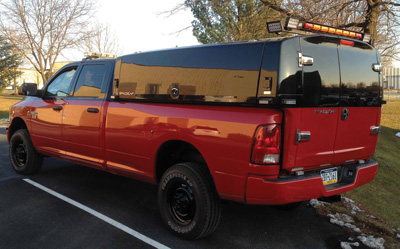 |
| (3) The SpaceKap bodies are designed to fit any eight- or 6½-foot domestic pickup, including Ford, Chevrolet/GMC, and Dodge. Depending on the equipment intended to be carried, a ¾- or one-ton pickup is usually suitable. |
Concept Unit
In terms of equipping the unit, Evans says configurations are only limited by the purchaser’s imagination. “ESI acquires the empty body shell,” he says. “Then it is up to our design team and the customer’s imagination to fill the interior with the compartments, trays, slide-out mechanisms, and so on that will house the equipment in an efficient, easily deployed, and ergonomic way.”
The first unit ESI produced was built on an eight-foot pickup bed using a SpaceKap RIU configured to carry the following: bunker gear, SCBAs and spare cylinders, and first-in hand tools for two firefighters in two side slide-out trays; EMS first-response equipment, swiftwater rescue equipment, a thermal imaging camera, and a multigas meter in two side compartments; and a full system of portable hydraulic rescue equipment, stabilization systems, pike poles, power hand tools, a shovel, a broom, two backboards, a Little Giant® ladder, bolt cutters, spill material, a mini come-along kit, pressurized water and dry chemical extinguishers, traffic cones, tool kits, and highway vests all placed on a rear slide-out tray and slide-out wall.
In addition, it’s equipped with a Fire-Caddy self-contained suppression system that provides 40 gallons of water and 2.5 gallons of class A foam pumped through 75 feet of ¾-inch forestry line with an aspirating nozzle. Finally, a Command Light Shadow RT four-LED-head light tower sits on the roof.
Evans says, “A lot of work can be accomplished out of a design such as the RIU, but ESI has created other designs such as traffic control/fire police, paramedic responder, incident command, fire investigation, incident rehab, and search and rescue.”
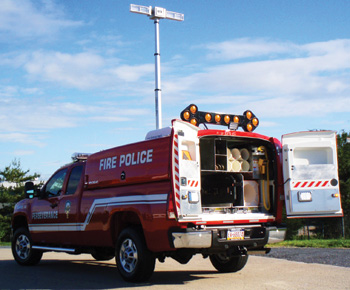 |
| (4) The RIU body differs from Fibrobec’s commercial body in many ways. The roof is reinforced to accommodate light towers and other such devices. There is 10 percent more fiberglass used in production, and there are two additional insulation barrier layers sandwiched in the body. |
The Spec Process
Evans says that when a customer specs a unit like the SpaceKap RIU, the customer usually has a specific vehicle need. From there, ESI’s design team asks questions to determine the customer’s current and potential future needs. Then ESI shows the customer a list of standard configuration options to see if any preconfigured designs meet its needs. “If so, a computer-aided drawing is completed, and the design is reviewed with the customer,” says Evans. “If there is any need for custom designs to store specific equipment, ESI will offer concepts and work with the customer until the design is finalized to [the customer’s] satisfaction.”
The SpaceKap bodies are designed to fit any eight- or 6½-foot domestic pickup, including Ford, Chevrolet/GMC, and Dodge. Depending on the equipment intended to be carried, a ¾- or one-ton pickup is usually suitable. “The nice feature on the design of the body is that any RIU body can fit onto any pickup bed, no matter the make or model,” Evans asserts. “Body frames are specific to the pickup bed, which means the RIU body can be generic in nature. The body never touches the pickup bed except where the four corner clamps secure under the bed sill. Once an end user is finished with the pickup as a response unit, the user can slide the body off and reuse the untouched pickup bed for utility purposes.”
Evans says that once a specification is approved, the SpaceKap body takes four to six weeks to arrive at the ESI facility, and then it takes another four to six weeks for ESI to produce a completed unit. “That timeline always depends on options and features,” says Evans. “Most pickup trucks can be purchased by customers through their state contract processes, so ESI rarely is involved with the pickup purchase. We will provide suggestions and requirements on the pickup chassis that are best suited for the intended use.”
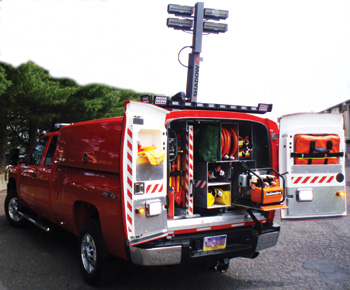 |
| (5) The concept unit is equipped with a Fire-Caddy self-contained suppression system that provides 40 gallons of water and 2.5 gallons of class A foam pumped through 75 feet of ¾-inch forestry line with an aspirating nozzle. A Command Light Shadow RT four-LED-head light tower sits on the roof. |
ESI provides a sales staff, a design team, and complete finishing capabilities that include complete emergency warning packages for both the SpaceKap RIU and the pickup cab. Because the SpaceKap bodies slide into the pickup bed, ESI can build a unit without having the pickup at its location. All wiring connections use automotive plugs to separate the RIU from the body and the pickup cab. “If a customer desires to install the body itself, ESI can complete the body, ship it to the customer, and the customer can complete the unit at its location,” Evans states. This concept, according to Evans, means that a finished RIU can be shipped anywhere in the world where the end user can finish the installation.
Customer installation also allows departments to transfer an RIU body when the chassis is retired or damaged beyond repair. Evans suggests that if a department is accustomed to heavy use, the cost for a new response vehicle, after the initial purchase, is for a new pickup chassis and cab accessory installations. The payback of any initial cost is typically after the first re-chassis. “Expected lifespan of the RIU body is 15 to 25 years depending on use, abuse, and maintenance,” he says.
He adds that what many customers don’t realize is that ESI’s lengthy experience in custom mounting equipment in emergency apparatus means the company can fit much more equipment in the limited space of the SpaceKap RIU than what a customer thinks is possible. “Our forte is designing and installing as much equipment into as little space as possible,” he says.
Where Does an RIU Fit?
Evans asserts that an RIU will fit almost anywhere in a fleet, including as an emergency vehicle, repair technician’s truck, fire police unit, fire investigation unit, or for water rescue purposes. “The initial thought by departments is for a quick-response or light rescue unit,” says Evans. He expects that until end users get comfortable with the capabilities of a small water/foam system for quick attack on vehicle fires, trash fires, or brush fires, acceptance for fire suppression will be slow. “In other countries around the world, small water/foam attack units, like the Fire Caddy system, are used daily for many purposes,” he comments.
Still, according to Evans, the reality is that many budgets are being severely reduced for the emergency services, and if the longevity of large fire apparatus can be extended by using the RIU for most responses, then funds typically used for maintenance and operations can be diverted to other projects. “The RIU concept, if designed purposefully, can reduce operating costs for a department and save the big trucks for the big jobs where they will always be needed,” Evans says.
Additionally, Evans says, “We later discovered that in the volunteer services as calls were dispatched, many departments could not guarantee specialized drivers’ response for large apparatus. The RIU permits many other members to drive a first-response vehicle with crew because of its size.”
CHRIS Mc LOONE, associate editor of Fire Apparatus & Emergency Equipment, is a 19-year veteran of the fire service and an assistant chief with Weldon Fire Company (Glenside, PA). He has been a writer and editor for more than 15 years. While with Fire Engineering, he contributed to the May 2006 issue, a Jesse H. Neal Award winner for its coverage of the Hurricane Katrina response and recovery.

